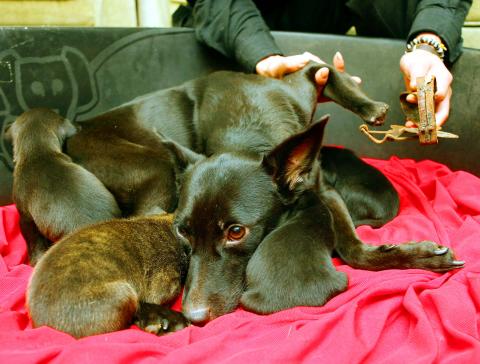Animal rights activists yesterday urged the government to ban the purchase and sale of animal traps, as many pets as well as children have fallen victim to them.
Showing a picture of a black dog surrounded by seven newborn puppies, Juan Mei-ling (阮美玲), executive director of Life Caring and Animal Rescue Organization, said the dog lost part of its front paw after being caught in a trap in Sindian District (新店), New Taipei City (新北市), last month.
“The dog was pregnant when it was found, so the veterinarian could not operate on her,” Juan told a news conference in Taipei. “When we could finally do the operation after the puppies were born, the wound has become so bad we could only cut off the palm.”

PHOTO: CNA
Juan said that the Sindian case was not an isolated one.
Each year, hundreds of pets, as well as stray dogs and cats, are injured by animal traps across the country, she said, adding that children had sometimes become victims, too.
“Our rescue team has saved many cats and dogs wounded by animal traps — but sometimes these wounded animals away out of fear and pain, and we don’t always find them,” Juan said, while urging the government to ban sale of animal traps to prevent further injuries.
Supporting Juan’s call, Democratic Progressive Party Legislator Tien Chiu-chin (田秋堇) cited the case of an Austrian girl who almost broke her arm when she accidentally touched an animal trap.
“That led to a complete ban of animal traps in that country,” she said.
“The government should not wait until a tragedy like that happens in Taiwan before banning animal traps,” she said.
Lin Tsung-yi (林宗毅), a Council of Agriculture official who attended the news conference, said that under current laws, “the use of animal traps is restricted, but sales are allowed.”
“If we are to prohibit sales [of animal traps], we have to talk to the Ministry of Economic Affairs about revising the law,” Lin said. “But before doing so, we’ve asked stores selling animal traps to instruct buyers about the rules on using animal traps. Right now, misuse [of animal traps] is subject to a fine of NT$15,000 to NT$70,000.”

SHIPS, TRAINS AND AUTOMOBILES: The ministry has announced changes to varied transportation industries taking effect soon, with a number of effects for passengers Beginning next month, the post office is canceling signature upon delivery and written inquiry services for international registered small packets in accordance with the new policy of the Universal Postal Union, the Ministry of Transportation and Communications said yesterday. The new policy does not apply to packets that are to be delivered to China, the ministry said. Senders of international registered small packets would receive a NT$10 rebate on postage if the packets are sent from Jan. 1 to March 31, it added. The ministry said that three other policies are also scheduled to take effect next month. International cruise ship operators

HORROR STORIES: One victim recounted not realizing they had been stabbed and seeing people bleeding, while another recalled breaking down in tears after fleeing A man on Friday died after he tried to fight the knife-wielding suspect who went on a stabbing spree near two of Taipei’s busiest metro stations, Taipei Mayor Chiang Wan-an (蔣萬安) said. The 57-year-old man, identified by his family name, Yu (余), encountered the suspect at Exit M7 of Taipei Main Station and immediately tried to stop him, but was fatally wounded and later died, Chiang said, calling the incident “heartbreaking.” Yu’s family would receive at least NT$5 million (US$158,584) in compensation through the Taipei Rapid Transit Corp’s (TRTC) insurance coverage, he said after convening an emergency security response meeting yesterday morning. National

PLANNED: The suspect visited the crime scene before the killings, seeking information on how to access the roof, and had extensively researched a 2014 stabbing incident The suspect in a stabbing attack that killed three people and injured 11 in Taipei on Friday had planned the assault and set fires at other locations earlier in the day, law enforcement officials said yesterday. National Police Agency (NPA) Director-General Chang Jung-hsin (張榮興) said the suspect, a 27-year-old man named Chang Wen (張文), began the attacks at 3:40pm, first setting off smoke bombs on a road, damaging cars and motorbikes. Earlier, Chang Wen set fire to a rental room where he was staying on Gongyuan Road in Zhongzheng District (中正), Chang Jung-hsin said. The suspect later threw smoke grenades near two exits

The Forestry and Nature Conservation Agency yesterday launched a gift box to market honey “certified by a Formosan black bear” in appreciation of a beekeeper’s amicable interaction with a honey-thieving bear. Beekeeper Chih Ming-chen (池明鎮) in January inspected his bee farm in Hualien County’s Jhuosi Township (卓溪) and found that more than 20 beehives had been destroyed and many hives were eaten, with bear droppings and paw prints near the destroyed hives, the agency said. Chih returned to the farm to move the remaining beehives away that evening when he encountered a Formosan black bear only 20m away, the agency said. The bear